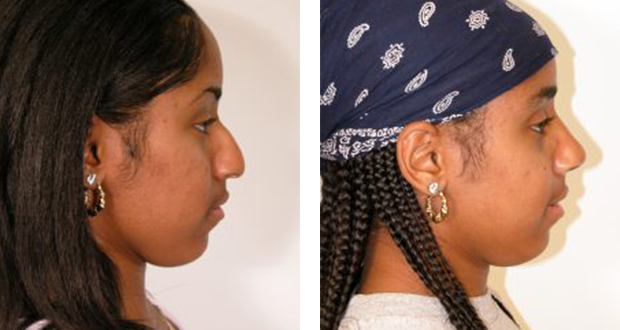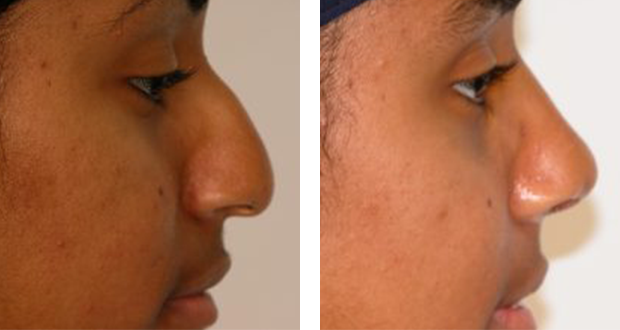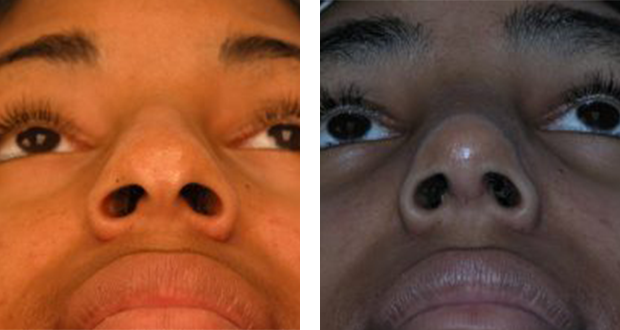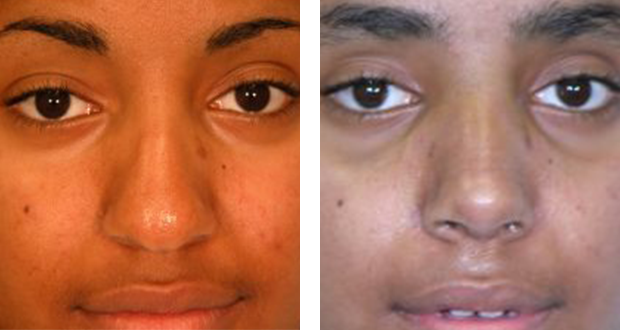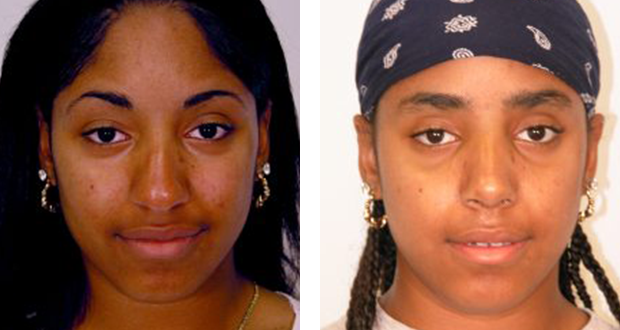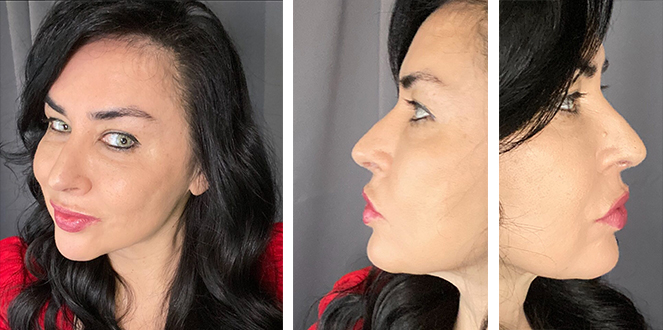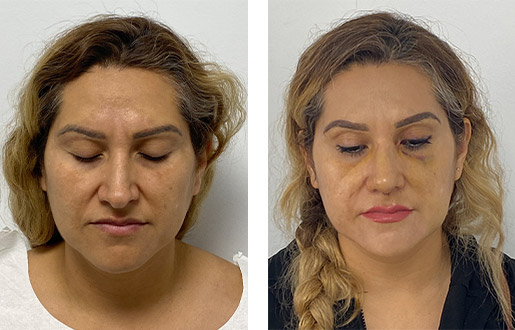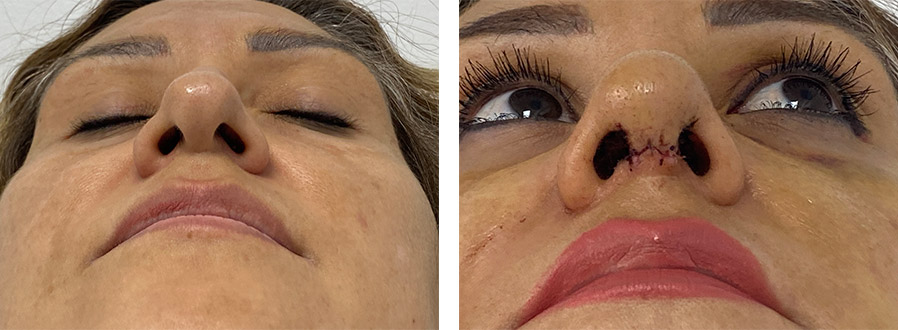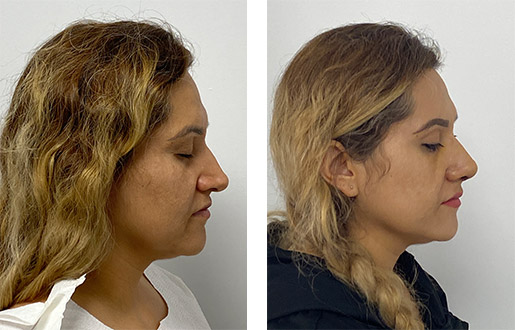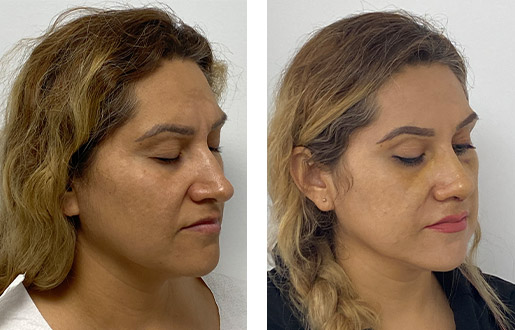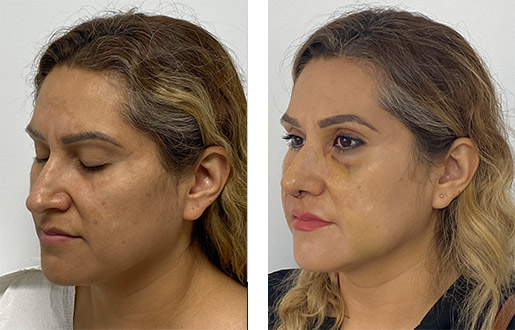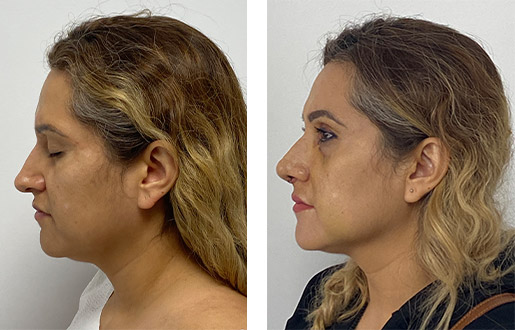What is Rhinoplasty?
Rhinoplasty is a procedure that has a pronounced effect on a person’s appearance. Procedures like liposuction is like polishing a car, a rhinoplasty is like getting a new car. Patients’ self-image is very connected to the appearance of the face in the nose. In particular, when you change the nose, you change your internal picture of yourself. This is a fact that should be considered when a nose job is planned.
What Types of Rhinoplasty Are There?
There are two nose improvement procedures: open rhinoplasty and closed rhinoplasty. Open rhinoplasty has become more common and popular in recent years. In an open rhinoplasty, the skin of the nose is raised away from the underlying cartilage and bone, allowing exposure to the shape-forming structures and allowing the surgeon to make a dramatic change. Closed rhinoplasty is a procedure where incisions are made inside the nostril. Colleges are delivered through the incision; changes are made in the cards and returned to their normal location. It is more difficult to make dramatic changes in the nose through a closed procedure than an open procedure that allows visualization of all of the anatomy. Rhinoplasty is a surgery of anatomy. The nose has a lot of anatomy in a small space.
There are generally two types of procedures. One is taking away, and the other is adding. A patient with a large dorsal hump will have bone and cartilage removed; this is taking way. A person with a small dorsum or tip will have an implant or cartilage.
My experience was great! My results are amazing!! Thanks Dr. Perry
MoreFeatured Procedure Video:
Video Transcript:
Today we’re going to talk about open rhinoplasty. Open rhinoplasty is a procedure that changes the shape of the nose and it’s called an open rhinoplasty because what we’re doing is just lifting the skin away from the bones and cartilages below in order to expose them to make changes. So when we do an open rhinoplasty, we make an incision through what’s called the columella, which is in the base of the nose, incisions inside the nostril, and then lifting the skin away from the nose to expose the nose. And that way we’re getting a complete exposure of all the bones, all the cartilages of the nose so you can make changes, make precise changes, and get the changes and the shape that you want to obtain. Now there are three really parts of the nodes that we kind of look at, we look at what’s called the bony dorsum which is here. Then we have the cartilaginous dorsum, which is here, which also contains the upper lateral cartilages. Then we have the lower lateral cartilages in here that are more of two dome shape cartilages, and then we have the septal cartilages right down the middle. And the septal cartilage is really the strength of the cartilage, like the tip posts in supporting the nose and things like that.
So that’s kind of the idea of the areas we’re dealing with. Big part of rhinoplasty is analysis. So you have to look at the nose, figure out what you don’t like about the shape, what you want to change, and then figure out how you want to change it. So in general, when we kind of look at her nose, we’re looking at one thing is we’ve seen a wide tip, so broad tip or non-refined tip. We’d like to make the tip a little narrower. The width of the nose, we’d like to also maybe bring the width of the nose in a little bit. When we look at the lateral side, we see a dorsal hump. So we’d like to smooth down this dorsal hump. And the other thing we see is the angle between the lip and the nose is a little bit acute. We always like to kind of have it a little bit at 90 degrees, a little bit higher for women, maybe at 90 degrees for men, but not down. So this is a little bit down and we like to have the tip, the most projecting part of the nose, we don’t want the dorsum to, you know, to see the tip, we want the tip to kind of project more than the dorsum. So that’s what we’re doing when we’re doing the analysis.
The big strength, the big part of the procedure is really called…is the tip work. What I do and what most plastic surgeons do, or a lot of plastic surgeons do, is suture techniques on the tip. Suture techniques on the tip mean that instead of cutting the cartilage in half and moving it around, we’re keeping the cartilage more intact and then just bending it and changing shape with sutures. I think the advantage of that is, overtime, it’s a more stable structure, less likely to collapse, change move, and things over time. No cut edges that will poke through the skin over 20 years. So I think that it’s a better procedure than cutting the cartilage and having blunt edges and things like that against the skin. So that’s kind of the idea. So again, if we kind of just drew a little bit of nose and you know, have a nose here and things, you know, we’d have, you know the upper lateral cartilages or the nasal, I’m sorry, where the nasal bones in the middle, then we’d have an upper lateral cartilage. And then at the bottom, we’d have the lower lateral cartilages which kind of shaped like two domes then the nostril and things would be here. So if we’re looking from the bottom, the lower lateral cartilage would kind of be shaped, or there’d be a septal cartilage in the middle. The septal cartilage is a struct that is really like the tip post that supports the nose, and then on either side, we have lower lateral cartilages so there would be something like this. So you can see the lower lateral cartilages are separated apart, we have a wide tip. And then we have, you know, more of a round angle. So what we’re doing with the suture technique is we’ll place sutures in here and with that, we can pull the tip up to get more projection, pull it down, manipulate and pull where we want and then also, you know, we put sutures across through here so now we can pull, you know, the cartilages this is a septum, you know we can pull the cartilages very close to the septum, you know with our sutures, and we can also extend this up to get more length. And then lastly, you can put sutures across the dome. And we do that, we kind of turn something that’s wide, you know, into something that’s narrow. So we put sutures here, sutures here, sutures here and at the base, and now we’ve turned something again, that was like the Golden Arches to something that’s more like a pyramid.
So this way we can have a tip, you know, that’s much smaller and more refined and then we also get projection, you know, by bending this out we can stretch and get projection. The additional thing we can do to get projection is we can take cartilage from the septal cartilage, the ear, or anything like that, and then we can also place it on top and with the septal graph and then we get more projections. So these are the things we do to kind of give us an opportunity to strengthen the nose, give more projection, give more definition. And you can kind of also see when you turn this into kind of more of a pyramid, you narrow the base of the nose. So the suture techniques on the cartilage also narrow the base of the nose, you know, by themselves. Now, when we do… when we have too much dorsum and we have to resect bone or cartilage, what we’re doing is, if you think about it at the noses, we’re looking at the bottom again, and the nose is shaped like this, what we have to do is, and the nose is too high, we’d have to take that hump off. So now after we take that hump off, you know, with the taking away the bone, and then also taking away the extra cartilage, we’re left with what’s called like an open roof. So you’re taking the top off, now it’s flat.
Now this is where the breaking the bones come in. Breaking the bones is called in-fracturing and when we’re breaking the bones, you break it really at the base and then you allow this flat, you know, a lot of the cartridges to fall back in and now we close the roof again after you break the bones here. You know, if the bones are like this, you break them and allow them to fall in. Whenever you take off the dorsal hump, now you have a flat area on top, the only way to get the cartilages and the bones back together is to break the bones and allow things to fall together. So that’s what we’re doing, we’re doing a hump resection, and we’re, you know, you automatically if you cut the top off, the roof off, you have an open roof, and then now we’re closing the roof by letting the walls come back in. So those are the things we’re doing, you know, mechanically, in order to make changes in the tip. Again, the big deal is really the suture technique on the tip. Again, we’re starting off, you know, with the golden arches, and then we’re changing the shape, you know, to a pyramid. And then that’s giving us a tip that’s this wide, instead of a tip that that that’s that wide. So that’s kind of the idea of what we’re doing with the suture techniques at the tip.
Now rhinoplasty, you know, are not a very, very painful surgery as surgery goes. It’s really more of a swelling, a throbbing, achy kind of pain than a knife pain. Most people don’t need a lot of days of pain medicine things with the rhinoplasty, but now you’re very swollen and if you break the bones you’re even more swollen. So most people do not work for a week, you know, after rhinoplasty or 10 days not because of the pain but just because the swelling is just too much to be normal. Most times after a week or 10 days, the swelling is down to you know, is down to something reasonable and people go back to work, but it really takes three months, even six months for all the swelling to go down to get the kind of the idea of the final look and things of the rhinoplasty. It takes some time at least four months, you know, to kind of really see what the final result will be. There is you know, there’s nothing really special to do, you’re doing everyday things and things in recovery. But in the immediate recovery, you don’t want to do lifting and pulling and exercising because you raise the blood pressure, you know, blood vessel pops and you get bleeding in the nose and things like that, you know. You can’t exercise, you know, for about a month, you don’t want to, you know, get hit in the nose or something like that, because all these things are not stable, and you’re waiting for them to heal and get strong. But otherwise, everyday things you’re gonna go through, you know, from day one doing your everyday things and whatnot. So that’s kind of the idea, you know, of the recovery.
Probably the biggest complication that we’re gonna worry about is the nasal bone collapse. When you break the bones, you know, the bone could shatter. It’s very rare, but that’s a possibility. There’s different ways to break the bone. Sometimes you can make openings outside and break the bones sometimes and go through the nostrils and break the bones, but that is a complication of rhinoplasty. Infection is very rare because the face has a good blood supply, very good blood supply so you can get in all your immune factors and things and all your antibodies to fight infection. So it’s very rare to have an infection with a rhinoplasty. I’ve never seen an infection with a rhinoplasty. Now you can have a perforation in the septum. Now this can happen if you’re harvesting cartilage from the inside of the nose, you cut through both linings of the nose and you can have a hole through. If that happened, you’d have to do some kind of flaps and things to close that opening and things like that. You can have scarring in the nose, you could have a buffalo hump where the tissue in the base just above the lower lateral cartilages and things could scar and build up too strong and things like that, you know, and scar and make too thick and you have like a hump here and things like that.
The, you know, other complication could be, you know, scarring, bad scarring, keloid scarring, and things like that on the nose. If you, you know, you could have problems with breathing if the cartilages were weakened to things too much. And I think you know, and other than the complication of general anesthesia, I think those are the complications and things you have to think about with the rhinoplasty. Let’s look at the before and after pictures and kind of describe what we tried to do again. So this is a before and this is an after. Now when we look at it from the front, what I think is kind of the acute thing to notice is you can see two light reflexes from the front and those are the top of the two domes of the cartilage. And after we’ve changed shaped and pull the cartilages in and put a cartilage graph now we just see one light reflection on the dome. So that’s showing… So we’re getting more of a refined look, more of a narrow tip than we had before. The other thing is we had a downward going nose, you know, and you cannot see from the front you cannot see any of the nostrils. But as we raise the nose up to 90 degrees or slightly above, now we can see the nostrils. So this just face just looks a little bit softer than that. From the lateral aspect what we see is that dorsal hump. So this is a bony hump in the cartilaginous hump, we see the dorsum far exceeds the tip and that’s not what. We want with the tip to have more projection than the dorsum and we also can see that the angle is slightly less than 90 degrees between the lip and the nose. So after we’ve, you know, done our open rhinoplasty, add a tip projection, raise the tip, open the tip up to an angle at least 90 or slightly greater, taken down the buffalo hump and smooth it out by taking away bone and cartilage then broken the bones to allow it to fall in, now after which we have an angle slightly greater than 90 degrees and more of a flat dorsal hump, and we see a little break between the hump and the tip of the nose and we want the tip of the nose to be the most projecting part. And this is just a more refined nose and just more of a balanced nose and things like that.
So that’s kind of the idea, you know, of what we’re trying to do with an open rhinoplasty. Now here’s another photograph just showing, you know, about tip projection and kind of showing what we’re doing with these cartilages. This is, you know, this is after the skin has been elevated, and there’s lower lateral cartilages, the two McDonald’s golden arches are exposed, and you can kind of see how they’re kind of u-shaped. But if you see they’re flat across, you know, and you can just see, it’s wide, the width is very wide. So the width of that of those domes is very far apart and it’s very flat. So now this is after the suture technique, we put sutures connecting the cartilage, the lower lateral cartilage to the septum, and then the septum is right here, the cartilage in the middle. And then we’ve also connected the two together and then also put cartilages to bend and make the angles more acute. This is a tip graft, we’ve taken cartilage from the septum and put on the tip to get even more projection on the tip of the nose. So if you kind of see, if you look at the width of the cartilages here, it’s much narrower than the width before. And that’s what we’re trying to do to get more of a refined nose. And now if you look at this bird’s eye view of this patient, you can see the length of the tip, the length of the nose, you know, is much shorter than it was, you know, much shorter before than after, after we’ve change the shape of the cartilages, added the cartilage graft and that’s giving us a more of a refined tip.
Again, if you look the tip is wider than it is afterward. So this is the idea, you know, of an open rhinoplasty and what we’re trying to do. Most of the times we’re doing rhinoplasty, it’s more common that we have dorsal… that we’re taking away… in surgery, we’re taking away that dorsal hump where there’s too much tissue, but sometimes, you know there’s not enough in the dorsum now, we’re trying to add tissue. And either you can add some of you know, you can add cartilage from the ear, cartilage from the nose, you can add, you know, silicone, you know, you can add things you know silicone or Gore Tex and things on the top. You can even take bone from the skull and actually add to the dorsum if you need to add. Majority of times doing a rhinoplasty is really taking away from the dorsum but sometimes you do need to add. And so these are, you know, these are the things to kind of think about when doing a rhinoplasty. I mean, I hope this, you know, made sense to you and it gave you a better idea of what we’re doing with open rhinoplasty and how it works. And we’ll continue to try to make more videos. Take care, have a good day.
Who is a Candidate for Nose Surgery?
A good candidate for cosmetic rhinoplasty is someone who is in good overall health and seeks to improve the appearance or function of their nose. Ideal candidates may want to correct a nasal hump, adjust the size or shape of the nose, or address breathing issues caused by structural problems. It’s important that candidates have realistic expectations about the outcome and are at least in their late teens, as the nose should be fully developed before undergoing surgery. A consultation with a qualified plastic surgeon is key to determining candidacy for the rhinoplasty procedure.
Patient Results
Visit GalleryConcerns Addressed with Rhinoplasty Surgery
The surgical procedure has been shown to address various cosmetic and functional concerns, including:
- Size or shape of the nose
- Nasal asymmetry
- Hump or bump on the bridge of the nose
- Droopy or upturned nasal tip
- Breathing issues due to structural problems (e.g., deviated septum)
- Narrow nasal passages
- Nasal septum trauma repair (e.g., fractures)
- Creating a more balanced and harmonious appearance
Recovery from Rhinoplasty
Recovery from rhinoplasty typically takes a few weeks. Initial swelling and bruising around the nasal tissues and eyes subside within 7 to 10 days. Most patients can return to light activities after a week, but it’s recommended that they avoid strenuous exercise for about 4 to 6 weeks.
Splints or bandages may be applied to support the new nose shape during the first week, and follow-up appointments are essential to monitor healing. While visible improvements are noticeable early on, full results may take up to a year as swelling continues to decrease and the nose refines its final shape.
Rhinoplasty Complications
Complications associated with rhinoplasty can be migration of cartilage change in shape, scar tissue formation, infection, hemorrhage, keloid formation, dropping tip, collapse of cartilage, septal perforation and the complications of anesthesia.
Contact Dr. Perry for more information or to schedule an appointment.
 Video
Video Reviews
Reviews Gallery
Gallery